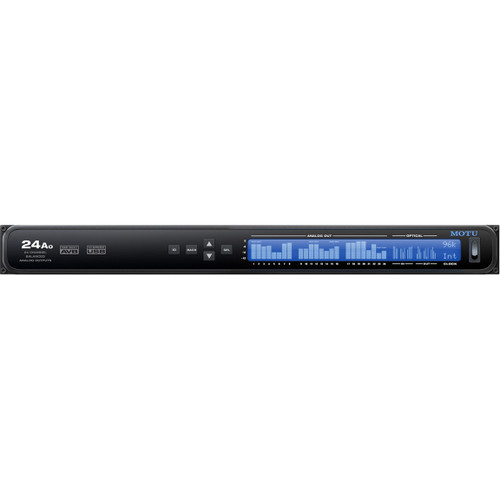The MOTU 16A Audio Interface delivers everything you need to turn your computer into a powerful 24-bit/192 kHz digital audio workstation. From studio to stage, the 16A delivers exceptional sound quality, state-of-the-art operation and rock-solid performance.
The MOTU 16A Audio Interface is the world’s first Thunderbolt 4 / USB4 audio interface connects to a Mac, PC or iOS device with extremely low-latency, high-performance drivers to deliver 66 channels of audio I/O, superb analog performance driven by renowned ESS Sabre32 DAC technology, 64-channel/32-bus mixing, and on-board 32-bit effects processing, including reverb, 4-band EQ, compressor and gate. Using intuitive, virtual patch cords in the include CueMix Pro™ app, easily route any source signal to any destination. Daisy-chain multiple 16A’s together using standard network cables connected to dual Gigabit AVB network ports, or build an AVB network with AVB switches. Advanced features include USB audio class compliant operation, word clock, A/B/C monitor switching, talkback, AVB audio networking, and Wi-Fi control from your phone or tablet.
MOTU 16A Audio Interface Features
- Next-gen 32 x 34 Thunderbolt 4 / USB4 audio interface: The world’s first Thunderbolt 4 audio interface built on 30 years of proven success as an industry-leading audio interface brand.
- New 3.9-inch TFT displays: Two bright, 24-bit RGB LCDs provide 480 x 128 pixel high-resolution metering for all analog and digital I/O, plus detailed status info and access to hardware settings from a simple and convenient menu.
- Superb analog audio quality and high-end converters: Renowned ESS Sabre32™ DAC technology delivers 125 dB dynamic range. Support for all standard sample rates up to 192 kHz.
- Ultra-low latency and proven, high-performance MOTU drivers: Round-trip latency (RTL) performance as low as 1.8 ms at 96kHz with high-performance DAW hosts.
- Universal Thunderbolt/USB-C connectivity: Connect to any computer with the included 40 Gbps Thunderbolt-compatible USB4 cable (compatible with USB3 and USB2) for up to 256 audio channels (128 in and 128 out), depending on the host computer connection. Class-compliant firmware and industry standard drivers work with any audio apps. Connects to an iPad™ with USB-C or a Lightning adapter kit (sold separately). Use an additional Thunderbolt port to connect additional computer peripherals, a USB hub or Thunderbolt dock.
- 66 simultaneous audio channels: 32 inputs and 34 outputs, including 16 TRS analog (line-level) in/out, two banks of 8-channel optical I/O, and a front-panel headphone output.
- 64-channel mixing with effects: Powerful 32-bit floating point DSP delivers 64-channel mixing with 64 inputs, 32 busses, and effects processing, including reverb, 4-band double-precision EQ, high-pass filter, gate and compression at all sample rates up to 96 kHz.
- Patchbay routing and splitting: Using intuitive, virtual patch cords, easily route any source signal to any destination. Split any source to multiple destinations.
- AVB Networking: Use two Gigabit network ports to daisy-chain multiple units using standard network cabling, or add an AVB switch to build a network with multiple interfaces and computers with ultra-low network latency, even over long cable runs (hundreds of meters). Stream hundreds of audio channels among devices and computers on the network. Compatible with previous-generation MOTU AVB devices.
- Wi-Fi control: Control everything wirelessly over Wi-Fi from the CueMix Pro app running on mobile devices or other computers on the same network — even multiple devices at the same time.
- Precision boost/trim for analog I/O: Calibrate analog input and output signals in precise 1 dB increments. Apply phase invert individually to analog inputs.
- Control room features: Control your sessions with "talk" button and "A/B/C" speaker select buttons to quickly compare your mixes on three sets of studio monitors.
- Flexible headphone output: With independent volume control and front panel source select knob, the headphone output can mirror any output pair, any CueMix bus, or any Thunderbolt/USB channels. Or create a completely customized mix that includes live 16A inputs and built-in reverb.
- Two banks of optical I/O: Connect outboard digital processors, digital mixers or other gear with 16 channels of ADAT at 44.1/48 kHz or 8 channels of S/MUX at 88.2/96 kHz. Bank A can optionally provide stereo TOSLink (optical S/PDIF) I/O up to 96 kHz.
- Word clock in/out/thru: Supports all sample rates up to 192 kHz.
- DC-coupled TRS outputs: Use the 16A to manipulate and sequence voltage-controlled modular synthesizers from ahost DAW.
- Loopback for live streaming and podcasting: Easily route computer output back to the computer, where you can mix it with live inputs from the 16A in your host software for live streaming or podcasting.
- Flexible front-panel metering: Choose customized meter views for analog I/O only, digital I/O only and other combinations to best support your workflow.
- CueMix Pro app: Control mixing and settings from your Mac, PC or iOS device. Note: iOS app coming soon to the Apple App Store.
- Performer Lite: Workstation software with over 100 included instruments, dozens of effects and 6 GB of included loops to make music right away.
MOTU 16A Audio Interface Includes
- MOTU 16A Audio Interface
- Power Cable
- Thunderbolt/USB4 compatible USB-C Cable
- Manufacturer Warranty
1 Review Hide Reviews Show Reviews
Write a Review
























 Sign Up for exclusive sales and offers!
Sign Up for exclusive sales and offers!